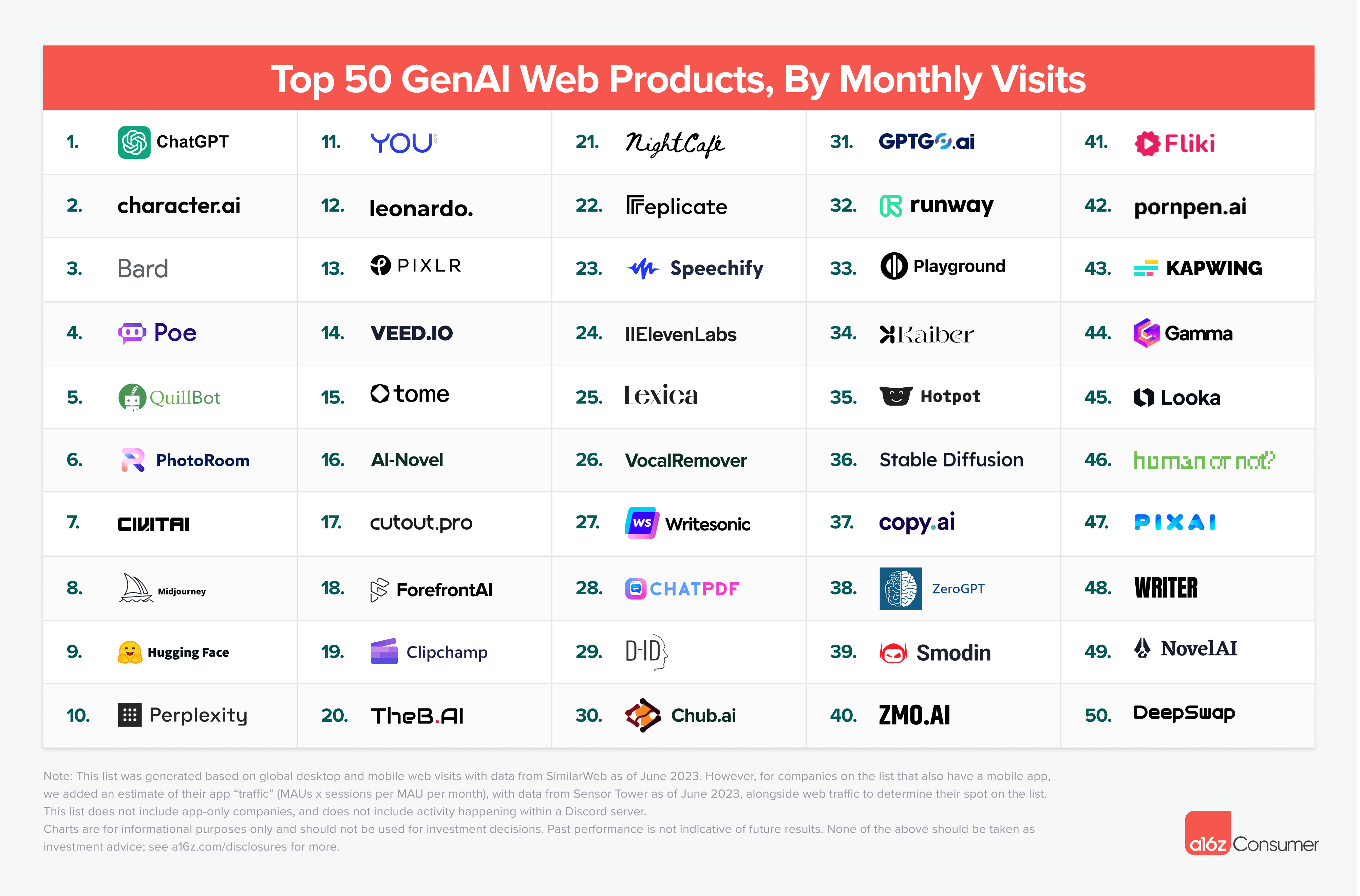AI Growth
It has been 9 months since ChatGPT was released and 7 months since it became the fastest consumer application to reach 100 million monthly active users, ushering us into the new era of Generative AI. The past few months have demonstrated remarkable growth and transformation. ChatGPT alone holds an estimated 1.6 billion monthly visits and 200 million monthly users (as of June 2023). Making it the 24th most visited website globally. However, how are consumers interacting with Generative AI products? And what is our collective experimental mindset when it comes to Generative AI? Compared to mainstream consumer products, even the biggest GenAI products are still fairly small. When combining web and mobile app traffic, ChatGPT ranks around the same scale as Reddit, LinkedIn, and Twitch but still far below the “giants” (WhatsApp, YouTube, Facebook, etc.).
The surge of AI has not merely been a blip on the radar but a fundamental shift that continues to reshape multiple industries. A perfect moment for us to take a moment to recap the journey thus far, explore the burgeoning opportunities for revenue and most importantly to enthuse you to start experimenting with the GenAI tools as well to help define the AI landscape.
AI Revenue
The impact of AI on revenue streams cannot be overstated. Businesses across sectors have harnessed the power of AI-driven solutions to not only streamline their operations but also unlock entirely new revenue streams. Consider, for instance, the recommendation engines that now grace our online shopping experiences. These AI algorithms analyze user behaviour, predict preferences, and seamlessly serve up product recommendations that resonate with individual tastes. As a result, cross-selling and upselling have become second nature, leading to substantial revenue increases.
AI's reach extends into finance, healthcare, logistics, and beyond. Predictive analytics models powered by AI crunch vast datasets to forecast market trends, enabling financial institutions to make smarter investment decisions. In healthcare, AI assists in the diagnosis of diseases by analyzing medical images and patient data, ultimately improving patient outcomes. Logistics companies optimize supply chain operations, reducing costs and ensuring timely deliveries through AI-driven route planning.
AI Responsibility
As we journey further into the age of artificial intelligence, it's crucial to pause and reflect on the path we've taken over the past few months. Responsible AI development is becoming a cornerstone of industry practices. The need for AI systems to be explainable, unbiased, and aligned with human values is non-negotiable. Government regulations and industry standards are emerging to guide the responsible development and deployment of AI, reinforcing the commitment to ethical AI practices. In this ever-evolving landscape, it is essential to stay informed about AI trends. Whether it's the rapid advancement of natural language processing models or the adoption of AI in addressing global challenges like climate change, the AI discourse continues to expand, pushing the boundaries of what's possible.
AI Ethics
While the growth in AI revenue opportunities is undeniable, the AI landscape has also witnessed a surge in discussions surrounding trend topics that shape its trajectory. One such critical trend is the ethical considerations surrounding AI. As AI systems become more integrated into our lives, questions of fairness, transparency, and accountability have come to the forefront. Companies like OpenAI are pioneering the development of AI systems that prioritize safety and ethical use, striving to reduce biases and ensure transparency in decision-making processes. It is up to us and the government to stay sharp on this and send signals when we think it is not desired.
AI in Online Marketing and Strategy
If we look at our own working industry, we see that the creative and marketing corners have been at the forefront of AI adoption. We as strategists see that agencies and marketers leverage AI algorithms to analyze customer behaviour, personalize content, and optimize ad campaigns. This not only saves time and resources but also leads to improved ROI. Also, AI-powered chatbots and virtual assistants are enhancing customer support and engagement, providing users with instant, personalized responses. However, it's essential to remember that while AI can automate tasks, the human touch remains invaluable in devising creative marketing strategies and interpreting AI-generated insights.
AI Mindset
Despite the buzz surrounding AI, many organizations are still in the early stages of experimentation. While there's a lot of discussion about AI's potential, practical implementations often lag behind. Companies might be cautious due to concerns about costs, data privacy, or a lack of understanding of AI's capabilities. To harness the full potential of AI, organizations need to move beyond talk and embrace a culture of experimentation. Pilot projects and collaborations with AI experts can help bridge the gap between aspirations and reality.

Example: The ’Artificial Client’ by Dentsu Creative Amsterdam
A new AI experiment recently launched by our creative agency Dentsu Creative "The Artificial Client" capitalizes on this knowledge and the scarcity of the right staff. This artificial intelligence-developed experience simulates different types of clients and provides feedback on TV commercials, brand identity and UX design. The Artificial Client is "modelled on three fictional customer archetypes and manages to provide feedback with a wink and a good dose of humour. For the 'relentless critic', even the best is never enough. The 'Idealistic Dreamer' is always ready to go bigger, further, and more extreme. And the third character, the 'Confused Creative' mainly pushes his own ideas. Choose one of the archetypes and upload a TV script, a brand identity or a UX design. Thanks to computer-generated speech, the Artificial Client can provide feedback in real-time. For more information, please refer to: www.artificialclient.com.
AI's role in online marketing and strategy is transforming the way businesses engage with their audience. However, there is still work to be done to move from discussions to real-world experimentation. Tread carefully and responsibly as you navigate the AI terrain. As we continue forward, let us embrace AI's potential while remaining vigilant about the challenges that lie ahead, ensuring that we make the most of this transformative technology. In our ongoing journey through the AI landscape, we have witnessed substantial growth, particularly in revenue opportunities and trend topics. The chances AI offers are undeniable, but it is essential to address the barriers that can impede progress. One significant barrier is the shortage of AI talent. As demand for AI professionals grows, businesses must invest in upskilling their workforce or consider partnerships with AI service providers. Data security and privacy concerns continue to be paramount, emphasizing the need for stringent regulations and ethical AI development. Additionally, the potential for bias in AI algorithms demands careful scrutiny and mitigation.
We invite you to adopt an experimenting mindset when it comes to GenAI tooling. Embracing an experimenting mindset with GenAI tools empowers us to unlock newfound creativity, generating innovative ideas and solutions effortlessly. By exploring the possibilities these tools offer, we can streamline our workflow, save valuable time, and elevate the quality of our work. In their personal lives, adopting this mindset fosters a sense of curiosity and discovery, enabling us to explore artistic expressions, automate tasks, and enhance our problem-solving abilities, ultimately enriching our daily experiences. For those that have hibernated throughout the summer and are willing to catch up on the top GenAI products, please find a top 50 list based on monthly visits below:

To close off in the words of Elvis Presley:
“A(I) Little Less Conversation, A(I) Little More Action, please!”.

